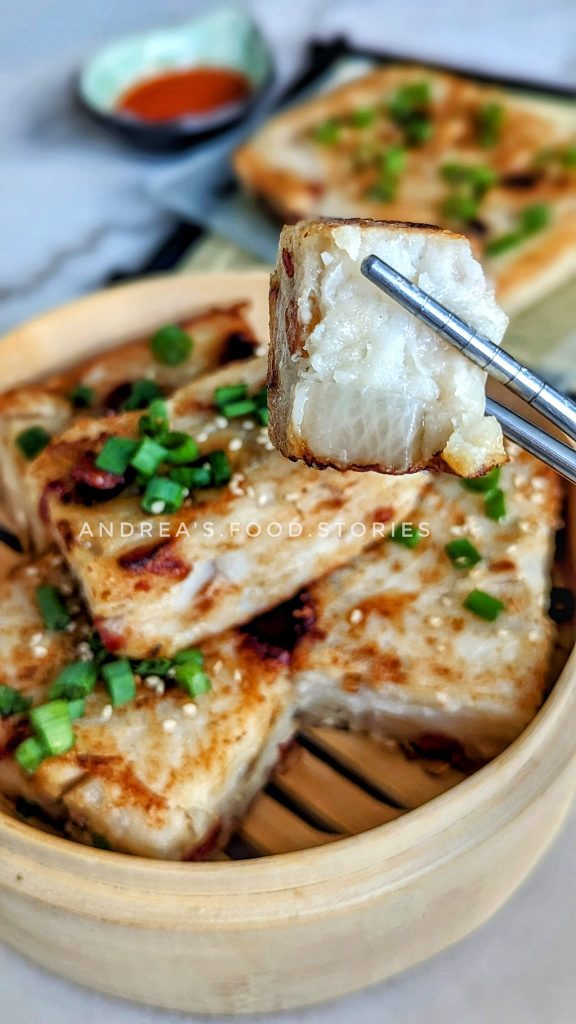
There’s something about the smell of turnip cakes cooking that always takes me right back to my childhood. Every year, without fail, my mom would make batches of these savoury delights, and they were always a hit with everyone—friends, family, neighbours.
But turnip cakes aren’t just tasty; they have a special place in our hearts, especially during festivals like Chinese New Year. They symbolize prosperity and good fortune. I can’t even count how many hours my mom spent in the kitchen, making turnip cakes for family and friends. But honestly? It was always worth it. Seeing the smiles on everyone’s faces as they enjoyed her homemade turnip cakes—that’s what made it all worthwhile. My sister and I especially loved when she served them up hot and crispy with a side of her homemade dipping sauce.
As I’ve grown older, I’ve come to appreciate the significance of carrying on my mom’s tradition of making turnip cakes while creating new memories with my kids. Ready to try your hand at making turnip cakes? Get ready to create some delicious memories of your own!
The Tradition of Turnip Cakes: A Symbol of Prosperity and Good Fortune
In Chinese culture, food is about more than just eating—it’s woven into our celebrations and traditions, reflecting our values and beliefs. Turnip cakes, or “Lo Bak Go/蘿蔔糕,” are a must-have during festivals like Lunar New Year. They’re loved not only for their delicious taste but also for what they represent. These cakes may be humble, but they’re hearty and full of meaning. They symbolize good luck, prosperity, and family ties. Eating them is thought to bring blessings and abundance, especially during special times like Chinese New Year. Ingredients like turnips are seen as symbols of wealth, while sharing and enjoying these cakes with loved ones strengthens the bonds of kinship and community.

Fresh turnips (sometimes called daikon radish): Turnips are the star of the show in turnip cakes, providing a unique texture and flavour. When grated and mixed into the batter, they add a subtle sweetness and a hint of earthiness. Plus, turnips are rich in vitamins and minerals, making them a nutritious addition to any dish.
To choose the best turnip/radish, look for ones that are firm, smooth, and free from blemishes. Smaller sizes are often more tender and flavourful. Opt for radishes or turnips that feel heavy for their size and have fresh, vibrant green leaves if attached.
Rice flour: Rice flour is the key to achieving the perfect texture in turnip cakes. It gives the cakes their signature chewiness and helps bind the ingredients together. Unlike wheat flour, rice flour creates a light and tender cake that’s just the right consistency. Make sure you’re not using glutinous rice flour.
Wheat starch vs. corn starch: Both commonly used as thickening agents in cooking, but they have distinct characteristics. Wheat starch, derived from wheat flour, offers a smoother and more translucent consistency compared to corn starch. It provides a softer, delicate texture in dishes like turnip cakes and is commonly used in Chinese cuisine for its unique properties. I prefer using wheat starch for its ability to create a nicer texture and appearance in turnip cakes.
Chinese sausage (lap cheong): Chinese sausage brings a tasty kick to turnip cakes, adding depth and richness. The sweet and smoky flavours of lap cheong blend perfectly with the other ingredients, enhancing the overall taste.


Cured meat or cured pork belly: Cured meat, often in the form of cured pork belly, adds a layer of indulgent richness and depth to turnip cakes. The savoury, salty flavour of the cured meat infuses the cakes with a delicious umami essence. Additionally, the tender texture of the meat provides a satisfying contrast to the softness of the turnip cakes. Also, the juices from the meats further enhances the flavour of the turnip cake. My husband is a big fan of this addition. Whether thinly sliced or finely diced, cured meat enhances the overall deliciousness of the dish.
Dried shrimp: Dried shrimp pack a punch of umami goodness in the turnip cakes. When rehydrated and chopped, they infuse the cakes with a rich, seafood flavour that adds complexity and depth.
Scallions: Scallions provide a fresh and aromatic element to turnip cakes, brightening up the flavour profile with their mild oniony taste. Their vibrant green colour also adds visual appeal to the finished dish.
Water: Water is essential for hydrating the rice flour and creating the batter for turnip cakes. It helps bind the ingredients together and ensures that the cakes have the right consistency when steamed. I use warm water to mix first and then add in hot water.
Salt: Salt is a crucial seasoning in turnip cakes, enhancing the flavours of the other ingredients and bringing everything into balance. However, when incorporating cured meat, only a pinch of salt is necessary as the meat already contributes a well-balanced flavour to the turnip cakes.
White pepper: White pepper adds a subtle heat and warmth to turnip cakes, without overpowering the other flavours.



Serving Suggestions
Crispy Pan-Fried Perfection: One of the most irresistible ways to enjoy turnip cakes is by pan-frying slices until golden brown and crispy on the outside, while still soft and tender on the inside. This is my favourite way to eat them. Heat a bit of oil in a skillet over medium heat, then add the sliced turnip cakes in a single layer. Cook until each side is beautifully golden and crispy, then serve hot for a delightful contrast of textures that’s sure to satisfy.
Dim Sum Delights: Turnip cakes are a classic addition to any dim sum spread, offering a savoury contrast to the more delicate flavours of dumplings and steamed buns. Serve them alongside other dim sum favourites like siu mai, har gow, and char siu bao for a delicious meal.
Dipping Sauce Diversions: You can elevate the flavour of your turnip cakes with a variety of dipping sauces that enhance their savoury goodness. A classic choice is a mix of soy sauce, rice vinegar, and a splash of sesame oil for a tangy kick. If you’re into a bit of heat, go for a spicy chili garlic sauce or a sweet and savoury hoisin sauce. My husband loves adding XO sauce to his. Feel free to get creative and experiment with different flavour combos until you find the perfect pairing for your turnip cakes.
And there you have it—the tasty journey of homemade turnip cakes, from childhood memories to delicious adventures! Grab your chopsticks and get ready to enjoy a bite of happiness. Happy cooking, and may your turnip cakes always bring a smile to your face and warmth to your heart!
Chinese Turnip Cake
Ingredients
- 2 lbs radish (daikon radish)
- 160 g rice flour (not glutinous rice flour)
- 2 tbsp wheat starch
- 25 g mushrooms (optional)
- 30 g dried shrimps (soaked for 10 minutes)
- 95 g Chinese sausages (lap cheong) (diced)
- 75 g cured meat (lap yuk) (diced)
- 1/2 tsp salt
- 1 tbsp sugar
- 1/4-1/2 tsp white pepper
- 2 cups warm water
Instructions
- Peel and grate the radish to your desired texture. I opted to grate most of it but reserved some to cut into chunks, as I enjoy the texture these chunks provide in the dish.
- Soak the dried shrimps in warm water for about 10-15 minutes to rehydrate and soften them up. Once softened, drain and chop them into small pieces.
- Dice the mushrooms, sausages, and cured meat into small pieces. Then, sauté all the ingredients together, including the shrimp, until they're nicely cooked and combined. Remove with all juices and set aside.
- Mix the shredded turnip with a cup of water in a wok or large pan, then bring it to a gentle simmer. Add in the sugar at this time. Adding sugar at this time not only enhances its natural sweetness but also helps to balance out any bitterness in the radish. Allow it to simmer for approximately 5-7 minutes or until the turnip becomes translucent instead of opaque. It should reach a fork-tender consistency without becoming mushy.
- During this time, get a large mixing bowl, mix together the rice flour and wheat starch. Slowly incorporate 1 cup of warm water to the rice flour and wheat starch while stirring continuously to create a smooth paste, preventing any clumps from forming. Next, add 1 cup of hot water and continue mixing until the mixture is completely smooth.
- Once the radish is cooked, add the flour mixture to the cooked radish in the wok or pan. Stir well to combine, ensuring that all the radish is coated evenly with the flour mixture. Then, add the cooked meats and other ingredients to the mixture. Mix until everything is well incorporated.
- Grease a 9-inch cake pan and any smaller pans if using. Scoop the mixture into the pans, spreading it out evenly. Place the pans in a steamer and steam for about 30-40 minutes, or until the turnip cakes are set and firm to the touch. Do the toothpick test.
- After cooking, let the turnip cakes cool slightly before cutting them into squares or wedges. I find that chilling them in the fridge overnight helps with slicing. Serve them warm as is or pan-fry until crispy on the outside. Enjoy your homemade turnip cakes with your favourite dipping sauce or accompaniments!
